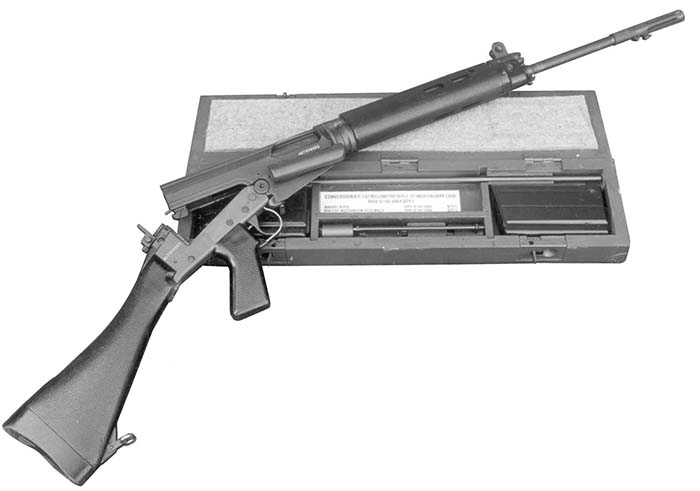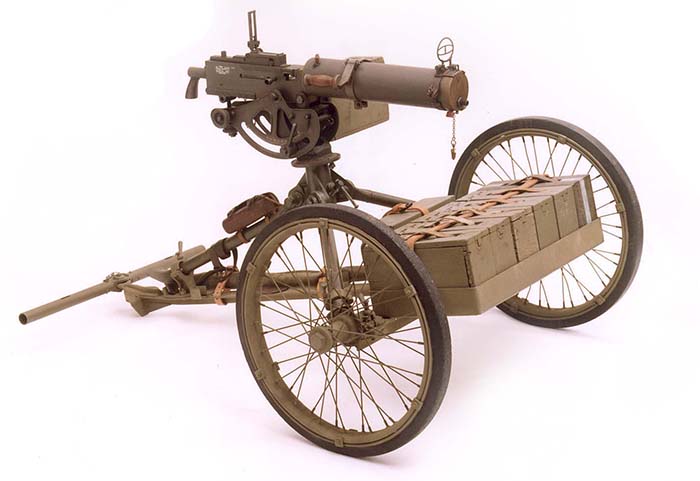The L12A1 conversion kit fits in the L1A1 type rifles. There have also been similar .22LR kits for the metric FALs.
by Janne Pohjoispaa
Subcaliber conversion kits for marksmanship training were quite popular in the era between world wars. In Europe, 4mm subcaliber barrels for the P.08 Luger and the C96 Mauser “Broomhandle” pistols were common during the 1920s and 1930s. Additionally, .22 LR rimfire versions of service rifles and pistols were developed for military training in several countries, yet few were actually adopted and issued in large quantities.
Things changed rapidly after World War II. The nuclear bomb and swift development of military technology during World War II turned military tactics and doctrines toward highly mechanized warfare. With few exceptions, the focus of military training on marksmanship and individual shooting skills received little attention.
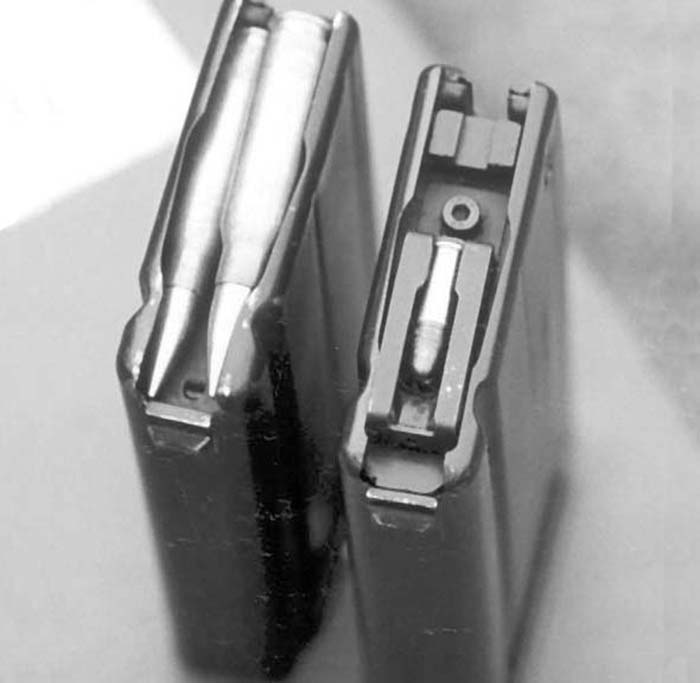
However, in 1959 UK MoD Armament Research and Development Establishment (ARDE) came to the conclusion that there was a need for a .22 rimfire version of their then-current 7.62x51mm NATO caliber L1A1 battle rifle for recruit training. An RFP (Request for proposal) was given to potential British and Canadian manufacturers and in the summer of 1959, the British company Birmingham Small Arms (BSA) introduced a .22 rimfire conversion for the L1A1 rifle. The .22 rimfire variation was actually the L1A1 converted permanently for firing .22-rimfire ammunition. The BSA training rifle had an excellent accuracy potential but it was too expensive and required permanent modifications for the rifle. Only a few BSA-converted L1A1’s were ever made. It was never adopted officially and the project for a .22 rimfire training rifle was cancelled. It is interesting to note that decades later, following the very same idea, the Brazilian firearm manufacturer IMBEL came up with a full-sized .22 rimfire caliber version of the FAL rifle. IMBEL .22 FALs, which are still available, have been produced in both semiautomatic-only and selective-fire configurations.
Back in England, the idea for a .22 LR rimfire counterpart to the L1A1 was revived in the 1970s. At that time Heckler & Koch made a .22 rimfire conversion kit for the Metric FN FAL. With minor modifications this conversion unit was also adaptable to Commonwealth FALs. The H&K .22 conversion kit was originally developed in the 1950’s for the German Bundeswehr FN FAL, known as the G1.
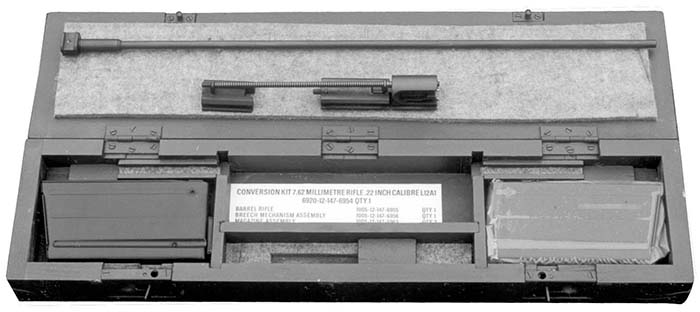
The L12A1 conversion kit is not a firearm per se. Not until it is properly installed can it be used for shooting. The L12A1 conversion kit consists of three main components: barrel, breechblock assembly and magazine. An original L12A1 kit includes two 20-round magazines which, together with barrel and breechblock assembly, were stored in a robust wooden box.
The barrel has an overall length of 549 mm (21.6 inches) and has six grooves with a right hand twist. When inserted in the L1A1 rifle barrel, it fits all the way up to the muzzle. The .22 rimfire subcaliber barrel outline follows the bore and chamber shape of the 7.62x51mm NATO barrel and fits tightly to L1A1 bore. The .22-rimfire barrel walls are very thin and care is required while handling the barrel assembly to prevent damage. After the barrel has been installed in the bore, the magazine and bolt guide sleeve on the breechblock assembly prevent removal of the subcaliber barrel.
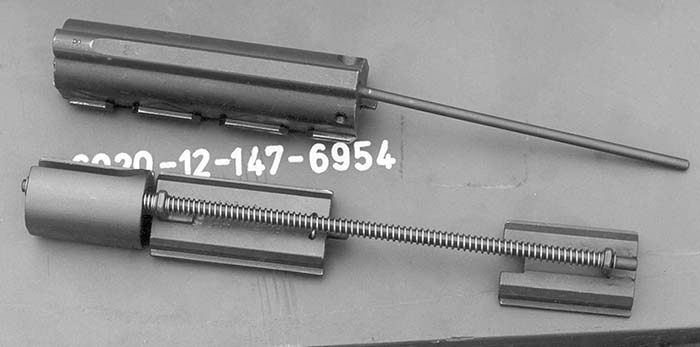
The .22 RF breechblock assembly includes the bolt body, bolt guide sleeve, bolt stop, recoil spring and the recoil spring guide which joins the breechblock components into a single assembly. This replaces the L1A1 slide and bolt.
The .22 RF bolt is of one-piece construction milled from a solid block of steel and weighs 6.3 ounces (180 g). The bolt face has no recess for the cartridge head as the chamber completely surrounds the cartridge. The single-claw extractor is a U-shaped hook stamped from sheet steel. The ejector is a small roll pin placed inside the bolt guide sleeve. The bolt guide sleeve serves also as the case deflector that forces expelled cases directly to the side. Ejected cases are expelled approximately 2 meters, regardless of cartridge type. The subcaliber assembly includes no separate cocking handle as the original L1A1 retracting handle serves for cycling the .22 rimfire bolt.
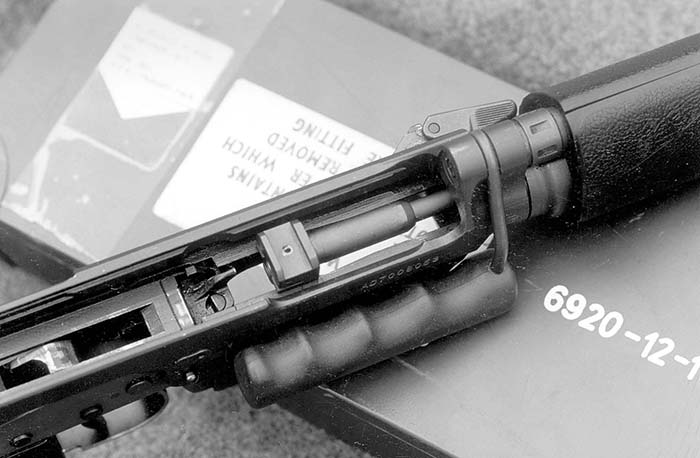
The L12A1 feed device is a single-column 20-round box magazine that is placed inside an original L1A1 magazine body. A single-column-type magazine is the most reliable feeding configuration for .22 rimfire firearms and serves this conversion well.
The L12A1 barrel and breech block will also fit in metric FN FAL uppers, yet due to the inch pattern of Commonwealth FALs, the conversion kit magazine works properly with British and Australian L1A1s only.
For evaluation purposes, the L12A1 conversion kit was mounted in an Australian Lithgow-made L1A1. Except for some small external details, the Australian version of the L1A1 is the very same as made in Enfield and Birmingham, England. Instead of a baked painted finish, Australian L1A1s have a “Parkerized” (phosphate) finish. Additionally, Australian-made L1A1s have chrome-lined bores and chambers while British-made rifles have only chromed chambers to ensure reliable fired case extraction. Both British and Australian L1A1s were originally issued with wooden furniture, but most British L1A1’s were later fitted with black plastic furniture while Australian rifles have wooden furniture made from native Australian hardwood called Coachwood.
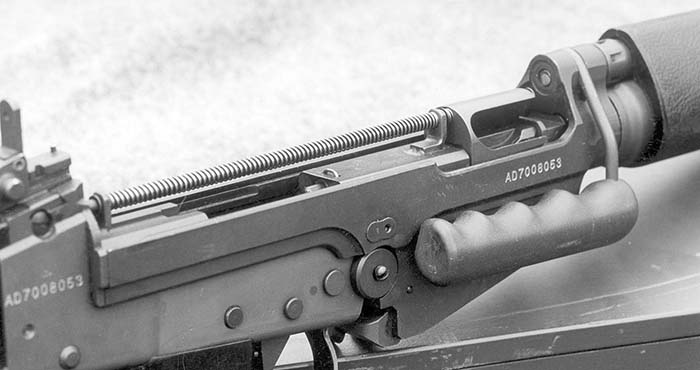
Installing the conversion kit requires removing the original bolt and slide and inserting the .22 rimfire barrel liner into the bore. After the conversion kit breechblock and magazine are installed, the .22 rimfire L1A1 is ready to fire. The charging handle, magazine catch/release and safety work as before.
Generally speaking, not all .22 rimfire subcaliber training devices work reliably, but the L1A1 .22 conversion kit does. In fact, it cycles more reliably than most .22 rimfire rifles with a wide range of different ammunition. We tested it with a substantial variety of standard-grade ammunition including Aguila Super Extra, Geco LR rifle, Lapua Super Club and CCI Standard. Only subsonic hollow-point-type ammunition is too light to cycle the action reliably.
The L12A1 conversion kit is an excellent example of the .22-rimfire conversion kits actually issued for military training purposes. It appears that not all of the kits purchased by UK MoD were issued to British troops. The L12A1 used for the SAR evaluation was in never fired, unissued condition.
| This article first appeared in Small Arms Review V7N11 (August 2004) |



